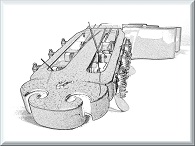Welcome to one of the most active flamenco sites on the Internet. Guests can read most posts but if you want to participate click here to register.
This site is dedicated to the memory of Paco de Lucía, Ron Mitchell, Guy Williams, Linda Elvira, Philip John Lee, Craig Eros, Ben Woods, David Serva and Tom Blackshear who went ahead of us.
We receive 12,200 visitors a month from 200 countries and 1.7 million page impressions a year. To advertise on this site please contact us.
|

|
|
What to use for lifting strings from saddle?
|
You are logged in as Guest
|
|
Users viewing this topic: none
|
|
Login  | |
|

  
Ruphus
Posts: 3782
Joined: Nov. 18 2010

|
 RE: What to use for lifting strings ... (in reply to Ruphus) RE: What to use for lifting strings ... (in reply to Ruphus)
|
|
|
Hi Stephen,
That can´t be it can it, when intending to file a saddle for most accurate intonation ( and setup)?
Putting on new strings to ensure best string eveness, letting them stretch in to somewhat hold pitch first, then starting to check each string for intonation, adjusting the saddle individually in minute steps as you go ...
With each time losening and retuning, and continuously tightening back up to pitch!?
I was thinking of tweaking within reasonable measures of time and patience. Like last time, when things worked out fine; only that getting the saddle out without losening strings did feel creepy. >shiver<
- While thinking of the least straining ... Shouldn´t the case be worth the making of an interesting little tool for luthier suppliers?
Elevating with the levering principle of those ramps that kitchen builder lift whole counters with, featering a prow that might allow propping up on the bridge itself and stuffed with a metal roll as lifting string support which again could be adjusted in final hight by one or two little screws.
Allowing you to lift the strings for just a breath higher than the saddle itself ( keeping increased pull at firmly controlled minimum ) and that with least of levering / rotating forces on the bridge as long as the rubber layered prow only finds enough place to rest on the bridges front heel.
Should make for a nice little milled gadget for luthiers and repairmen. Well worth from ~ 80 bucks upwards.
Especially if without it, strings will have to be slacked and tuned up with each adjusting of the saddle. ( Which should be just too cumbersome and lengthy for trying the saddle all too often. No?)
Is strings losening the way commonly done?
( I think to have picked up a levering approach from Frank Ford´s website, but don´t quote me on that.)
Ruphus
|
|
|
|
REPORT THIS POST AS INAPPROPRIATE |
Date Nov. 10 2012 8:17:07
 |
|

  
Ruphus
Posts: 3782
Joined: Nov. 18 2010

|
 RE: What to use for lifting strings ... (in reply to estebanana) RE: What to use for lifting strings ... (in reply to estebanana)
|
|
|
Hi Stephen,
Thank you very much for explaining so well, and pointing to measuring bridge position first, which I hadn´t even thought of.
I had been considering these things kind of esoterics, when my ears led me to it.
It was a while before leaving Germany, with me wanting to buy some concert level classical guitar before heading to hemisphere of lesser availability.
Been visiting one of Berlin´s best stores over a while, who on my following request ordered 4 additional guitars from a builder whose guitars asides were kicking ass a batch of guitars coincidentally present on behalf of a insanely expensive brands anniversary.
I liked best one of the sent in specimens, which besides came in comparably "cheap" at 4,800.00 EUR. However something was not right, and turned out to be intonation. So, I took it to the well educated staff and the store owner, but none of who could hear the misalignment.
I had to ask for an electronic tuner first to finally prove to them what was wrong.
As I liked the overall properties of this guitar I was already inquiring at someone who has specialized on precision intonation. ( Who will besides string up in both directions first to make sure about strings parameter performance, before starting procedure.) However, the store owner offered to compensate at the saddle first, and his staff did so perfectly to my full satisfaction.
This was when I learned about the significance of some minute measures at a saddle ( - and nut or fretting, for that matter ).
My experience with musicians, live or through exchange in forums, is that most won´t hear considerable deviation, lesser even within dimensions of around 0,1 cents.
- And it should be only consequential that also among makers meticulous luthiers in this aspect to be few. ( I even claim that there be rather demand for adjustment with your average luthier guitar than with your CNCed serial production batch. ... The one I currently like to adjust is a fine luthier guitar too, besides.)
And you don´t need to have a golden ear to appreciate finer accuracy in the first place;
as it shows when I fine tune someone´s guitar and hand it back. ( Or my own perception before, in times before knowing any whereabouts on the matter.)
Even when not educated enough to consciously perceive the detail of difference, any musical ear will clearly detect the effects of a good tuning to a familiar instrument. Which logically includes same perception with subtleties of intonation.
A precise tuning or intonation to a beforehand sloppy routine will make a difference of day and night, equalling the obtaining of a better instrument that will be better separating, more lush and harmonical and way more duende.
-
Ricardo, your apparent conclusion that strings uneveness would render precise settings useless is not entirely thought through, and practically refuting.
-
Stephen,
the 12th fret compensation would be a shortcut ( though certainly better than none) / not considering ( 5th and ) 7th harmonics, right? Or would it mean 12th fret compensation after having ensured 7th fret accuracy?
Ruphus
|
|
|
|
REPORT THIS POST AS INAPPROPRIATE |
Date Nov. 11 2012 9:52:18
 |
|

   
Ricardo
Posts: 14828
Joined: Dec. 14 2004
From: Washington DC

|
 RE: What to use for lifting strings ... (in reply to Ruphus) RE: What to use for lifting strings ... (in reply to Ruphus)
|
|
|
quote:
ORIGINAL: Ruphus
quote:
ORIGINAL: Anders Eliasson
quote:
You guys are crazy if you use "A string" of any brand to intonate a guitar. Is that REALLY how it's done? I am in shock as SO MANY times an intonation "problem" is the stupid imperfections of the string itself!!!!!!!
What are you talking about... Has this something to with this thread or something else?
I think he means that string diameters inconsistency ( which can be quite with some brands ) would make it senseless to strive for fine adjustment with the guitar.
Ruphus
Well, to be more clear....factors affecting intonation:
Assuming the guitar was constructed on the drawing board mathematically correct:
1. Strings.... I have never played the perfect set. Whenever a problem appears, no matter how minor WOOOOSH off they go. I don't waste time dealing with it. It's usually just one string but I have encountered bad batches of EVERY BRAND I have ever tried...so I am not afraid to go through a bunch till the guitar magically is perfectly in tune. THen you have to go the extra step if you are talking a full out set change...to give several days for them to settle before the harmonics start complementing each other...and of course there is danger that after those days you start killing them if you play a lot and even playing causes strings to go bad intonation wise to boot!!!!!
2. So lets say the strings are good by some miracle. Humidity. Just going from one room to another, a rainy day, whatever, affects the darn wood in a BIG WAY....it can make strings sound dull one day vs the next, change the action feel and with it ...the intonation. Not anything anyone can do about it unless you only use your guitar in vacuum sealed humidity controlled environment.
3. Finger pressure. That's right, just touching the strings affects the tuning, relative to the strings NOT touched (ie open strings). So any kind of intonation you think bone fussing is significantly affecting, is only involving the open strings (unless the guitar is set up with super low action like buzzing on frets by just breathing on the strings, and the frets are super low too). Higher action, scalloped neck, high frets, etc all for the players quite aware of the physical control they have over intonation. Doing a vibrato is delberate alteration of tuning of a single note. Doing barre chords on high action guitars it becomes obvious how careful one needs to be with finger placement and pressure.
4. Bone. Action is huge. THe lower the better intonation will be, and this is directly tied to number 3 above. Ok, say everything above is minimal, you have your guitar with perfect lazer selected strings, in your humidity controlled vacuu room, with your action set up super low over low frets and you only need apply the smallest pressure....so you have your compensated bone for the sake of your fatter or skinner strings. Well, over time of playing the bone is wearing out just like strings, only slower, but much faster than say your golpeador or the frets!!! So I admit it has some purpose of intonation regarding open strings relative to each other (good grief every body and their mom hates the G string, compensation, composite material, different color, wound, not wound, gut, carbon etc )....but when looking at percentages I can't believe it's doing all that much.
I have changed tons of bones on classical and flamenco guitars....and intonation issues are almost never (though it's common to blame) the physical aspects of the guitar build. CHange strings, action, playing technique, humidity issues...and the problem normally disappears. A compensated bone has no defense against all too common bad strings, bad playing, high action etc.
_____________________________
CD's and transcriptions available here:
www.ricardomarlow.com
|
|
|
|
REPORT THIS POST AS INAPPROPRIATE |
Date Nov. 11 2012 17:50:05
 |
|

   
jshelton5040
Posts: 1500
Joined: Jan. 17 2005

|
 RE: What to use for lifting strings ... (in reply to Ricardo) RE: What to use for lifting strings ... (in reply to Ricardo)
|
|
|
quote:
ORIGINAL: Ricardo
4. Bone. Action is huge. THe lower the better intonation will be, and this is directly tied to number 3 above. Ok, say everything above is minimal, you have your guitar with perfect lazer selected strings, in your humidity controlled vacuu room, with your action set up super low over low frets and you only need apply the smallest pressure....so you have your compensated bone for the sake of your fatter or skinner strings. Well, over time of playing the bone is wearing out just like strings, only slower, but much faster than say your golpeador or the frets!!! So I admit it has some purpose of intonation regarding open strings relative to each other (good grief every body and their mom hates the G string, compensation, composite material, different color, wound, not wound, gut, carbon etc )....but when looking at percentages I can't believe it's doing all that much.
Ricardo,
While I agree with most of what you state above. Since we compensate for string stretch if you lowered the action on one of our classics you would throw the intonation off. Same goes for the flamencos although it's mostly a very minor difference.
Stephen is correct that it's a very complex issue.
_____________________________
John Shelton - www.sheltonfarrettaguitars.com
|
|
|
|
REPORT THIS POST AS INAPPROPRIATE |
Date Nov. 11 2012 18:18:40
 |
|
 New Messages New Messages |
 No New Messages No New Messages |
 Hot Topic w/ New Messages Hot Topic w/ New Messages |
 Hot Topic w/o New Messages Hot Topic w/o New Messages |
 Locked w/ New Messages Locked w/ New Messages |
 Locked w/o New Messages Locked w/o New Messages |
|
 Post New Thread
Post New Thread
 Reply to Message
Reply to Message
 Post New Poll
Post New Poll
 Submit Vote
Submit Vote
 Delete My Own Post
Delete My Own Post
 Delete My Own Thread
Delete My Own Thread
 Rate Posts
Rate Posts
|
|
|
Forum Software powered by ASP Playground Advanced Edition 2.0.5
Copyright © 2000 - 2003 ASPPlayground.NET |
0.0625 secs.
|


 Printable Version
Printable Version













 New Messages
New Messages No New Messages
No New Messages Hot Topic w/ New Messages
Hot Topic w/ New Messages Hot Topic w/o New Messages
Hot Topic w/o New Messages Locked w/ New Messages
Locked w/ New Messages Locked w/o New Messages
Locked w/o New Messages Post New Thread
Post New Thread